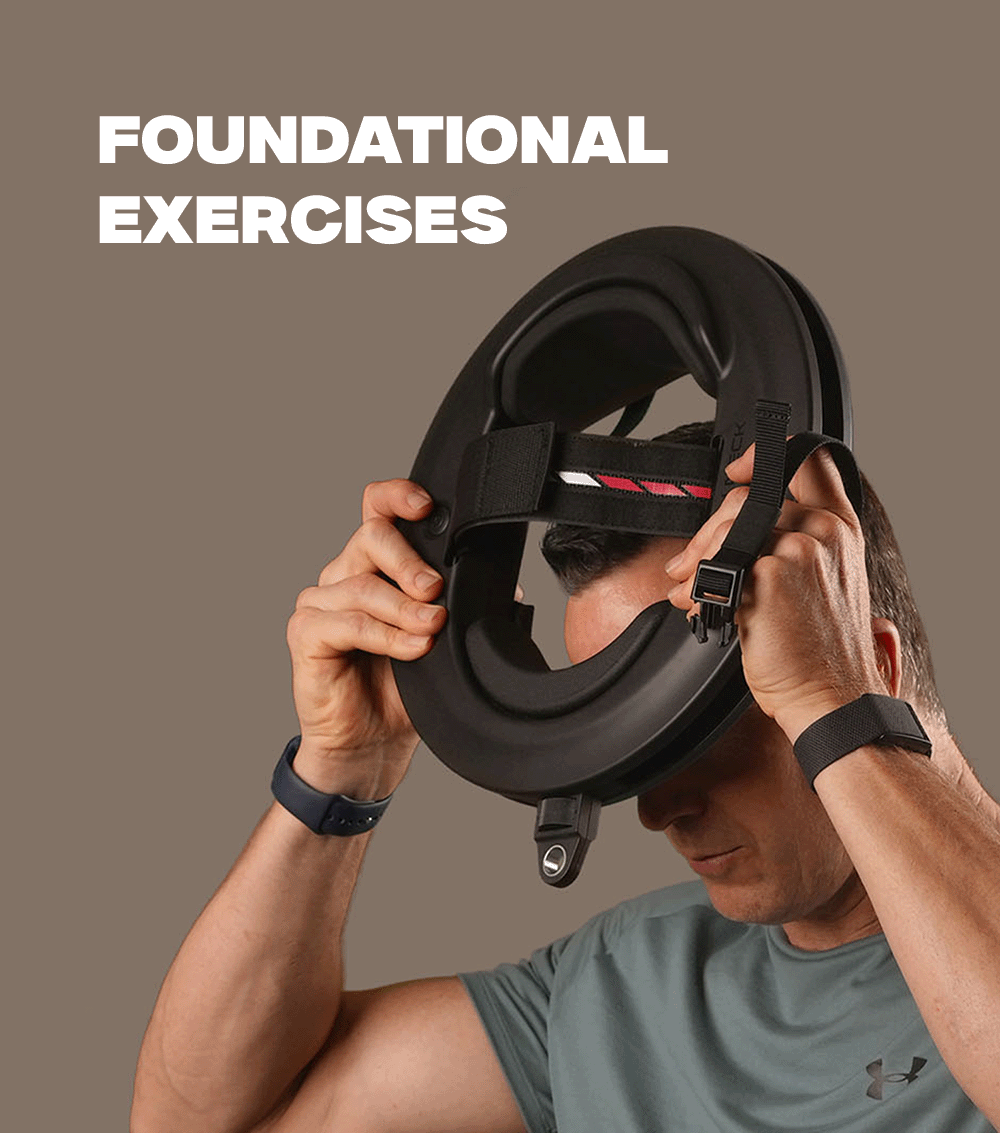Cervical vertigo can make everyday activities feel unpredictable. You might notice dizziness when turning your head, feel off-balance while walking, or experience a spinning sensation that comes and goes. These episodes can be frustrating, affecting work, exercise, and daily routines (Cohen et al., 2003; Reid et al., 2014).
Targeted head and neck exercises, combined with lifestyle adjustments, help manage symptoms and restore stability. Strengthening the neck, improving mobility, and supporting proper posture can reduce dizziness, enhance coordination, and support long-term neck and vestibular health (Sremakaew et al., 2022; Giridharan et al., 2024; Bhamre et al., 2024).
What Is Cervical Vertigo and Why Neck Health Matters
Cervical vertigo occurs when issues in the neck interfere with the brain’s ability to interpret signals about balance and spatial orientation. The neck is home to muscles, joints, and nerves that communicate with the brain and inner ear. When these structures are tight, weak, or misaligned, signals can become inconsistent, resulting in dizziness, lightheadedness, or a spinning sensation (Reid et al., 2014; Sremakaew et al., 2022).
Even small stiffness or misalignment in the cervical spine can disrupt the way the body senses movement. Over time, poor neck mobility can affect coordination, posture, and confidence in daily movement (Cohen et al., 2003; Giridharan et al., 2024). That’s why addressing neck health is crucial not only to relieve vertigo but also to prevent related complications such as chronic tension, headaches, or reduced athletic performance (Bhamre et al., 2024; Lystad et al., 2011).
For athletes and active individuals, maintaining neck health is even more critical. A stable, mobile neck allows for smoother transitions from intense activity to recovery, promotes better nutrient absorption, supports quicker muscle repair, and reduces the likelihood of injury. When the neck is compromised, fatigue lingers, balance suffers, and performance can decline (Hrysomallis, 2016; Rausch et al., 2021).
How Neck Misalignments Affect Balance
The cervical spine acts as a communication hub between the brain and body. Even minor misalignments or tension can cause signals to become distorted, confusing your sense of balance (Reid et al., 2014; Sremakaew et al., 2022). This often leads to:
- Sudden dizziness when turning the head
- Feeling off-balance while walking or standing
- Difficulty coordinating head and eye movements
By improving neck mobility and strengthening supporting muscles, you can stabilize these signals, reducing vertigo frequency and improving confidence in daily movement (Giridharan et al., 2024; Bhamre et al., 2024).
Common Triggers: Injuries, Posture, and Muscle Tension
Several factors contribute to cervical vertigo, including:
Neck Injuries:
Whiplash, strains, or trauma from accidents or sports can damage muscles and nerves, disrupting vestibular signals. Recovery often requires rebuilding strength, similar to approaches used in neck injury rehabilitation and sports performance programs (Reid et al., 2014; Hrysomallis, 2016).
Poor Posture: Long hours of sitting or standing incorrectly place constant stress on neck muscles and joints. Forward head posture, rounded shoulders, and slouching are common culprits (Sremakaew et al., 2022; Lystad et al., 2011).
Chronic Muscle Tension: Tightness in the neck, shoulders, or upper back can interfere with nerve communication, reducing mobility and balance (Bhamre et al., 2024; Cohen et al., 2003).
Understanding these triggers is essential to designing exercises and lifestyle strategies that effectively manage symptoms and prevent flare-ups (Giridharan et al., 2024).
Head and Neck Exercises for Cervical Vertigo
Targeted, controlled exercises strengthen supporting muscles, improve mobility, and stabilize the neck to reduce vertigo symptoms. Here are the most effective movements:
1. Neck Tilts

Slowly tilt your head toward one shoulder, hold for a few seconds, and return to center. Repeat on the other side. Neck tilts stretch side muscles, release tension, and promote better signal transmission from neck to brain (Reid et al., 2014; Sremakaew et al., 2022).
Tips: Avoid jerky movements and breathe steadily. Perform 8–10 repetitions per side.
2. Head Turns

Gently rotate your head left, hold for 2–3 seconds, then right. This exercise improves rotational mobility and helps the neck communicate accurately with the vestibular system (Giridharan et al., 2024; Cohen et al., 2003).
Tips: Keep your shoulders relaxed and maintain a neutral spine.
3. Chin Tucks

Sit or stand tall, gently tuck your chin toward your chest without rounding the shoulders. Hold for a few seconds and return to neutral. Chin tucks strengthen deep neck flexors, improve posture, and reduce strain on cervical structures (Reid et al., 2014; Sremakaew et al., 2022).
This same movement is often included in neck curl training, which focuses on reactivating deep stabilizers to support alignment and reduce tension.
Tips: Perform 10–15 reps, focusing on slow, controlled movements.
4. Isometric Neck Exercises
Place your palm against your forehead, temples, or the back of your head. Push gently while resisting movement. Hold 5–10 seconds, then release. These exercises build strength without large movements, stabilizing the cervical region safely (Sremakaew et al., 2022; Hrysomallis, 2016).
5. Controlled Rotational Exercises

Slowly rotate the head in small circles or diagonals while keeping the shoulders relaxed. This improves multi-plane mobility and prepares the neck for functional movements (Giridharan et al., 2024; Bhamre et al., 2024).
How to Care for Your Neck and Improve Balance
Taking care of your neck is about more than just doing exercises. Everyday habits play a big role in keeping your neck strong, relaxed, and better connected to your balance system.
- Posture Awareness: Keep your head in line with your spine when sitting, standing, or looking at your phone. Good posture reduces strain on the neck (Reid et al., 2014; Sremakaew et al., 2022).
- Hydration and Nutrition: Drink enough water and eat nutrient-rich, anti-inflammatory foods to keep your muscles and nerves working well (de la Corte-Rodriguez et al., 2024).
- Stress Management: Stress can tighten your neck muscles. Try deep breathing, mindfulness, or gentle yoga to stay relaxed (Dunleavy et al., 2016; Giridharan et al., 2024).
- Regular Movement: Take short walking breaks and add gentle stretches or mobility drills to avoid stiffness and improve circulation (Cohen et al., 2003; Bhamre et al., 2024).
How Iron Neck Supports Neck Health and Reduces Vertigo
Iron Neck provides progressive resistance and controlled mobility, helping users strengthen neck muscles in all directions. Unlike traditional exercises, it allows for targeted movements that stabilize the cervical spine safely, improving posture and coordination with the vestibular system (Hrysomallis, 2016; Rausch et al., 2021; Giridharan et al., 2024).
Recommended Iron Neck Exercises:
- Controlled flexion and extension
- Lateral side bends
- Rotational exercises for balanced strength
Benefits:
- Strengthens neck muscles safely (Hrysomallis, 2016)
- Corrects posture and reduces tension (Reid et al., 2014)
- Enhances coordination between neck and vestibular system (Sremakaew et al., 2022; Cohen et al., 2003)
-
Reduces risk of vertigo flare-ups over time (Giridharan et al., 2024; Bhamre et al., 2024)
Take Your Neck Health to the Next Level with a Structured Program
Managing cervical vertigo isn’t just about doing a few exercises here and there. Consistency, proper progression, and guided training make a real difference in reducing dizziness and improving neck stability (Sremakaew et al., 2022; Reid et al., 2014).
A neck-focused program, like the Iron Neck Training Program, combines targeted exercises, mobility drills, and progressive resistance to strengthen your cervical muscles safely. By following a guided routine, you can:
- Reduce neck tension and improve posture (Reid et al., 2014)
- Support better communication between your neck and vestibular system (Cohen et al., 2003; Giridharan et al., 2024)
- Minimize the frequency of vertigo episodes (Bhamre et al., 2024)
- Build long-term neck stability and confidence in movement (Hrysomallis, 2016; Rausch et al., 2021)
Programs like this provide structure and progression — key elements shown to enhance outcomes in neck rehabilitation research (Sremakaew et al., 2022; Reid et al., 2014).
Real Experiences, Real Relief
★★★★★ “Excellent concept, design and training” - Armin P
Excellent concept, design and training protocol. I’ve only been using it for about a week, though have already improved my upper cervical instability. I feel like my neck is becoming more integrated into my core, and I have less pain and discomfort. Have I finally found the magic bullet to eradicate my decade-long neck pain? We shall see…
Testimonials like this align with research showing that consistent neck-specific training can improve cervical stability, reduce pain, and enhance posture by strengthening deep stabilizer muscles (Reid et al., 2014; Sremakaew et al., 2022; Hrysomallis, 2016). Progressive, guided exercise—such as that used with Iron Neck—has been shown to improve proprioception and coordination between the neck and vestibular system, leading to functional relief in as little as a few weeks (Giridharan et al., 2024; Bhamre et al., 2024).

Building Long-Term Relief and Stability
Cervical vertigo can feel limiting, but consistent exercise, lifestyle adjustments, and tools like Iron Neck can make a lasting difference. A strong, mobile neck supports balance, reduces dizziness, and improves posture, while lifestyle habits like hydration, stress management, and gentle movement enhance recovery and resilience (Cohen et al., 2003; de la Corte-Rodriguez et al., 2024).
Over time, this holistic approach strengthens the neck, reduces discomfort, and improves overall function (Rausch et al., 2021; Sremakaew et al., 2022). Whether you’re managing vertigo or preventing it, combining mindful daily habits with targeted neck training creates a foundation for long-term stability, confidence, and improved performance in both everyday life and athletic activity (Hrysomallis, 2016; Reid et al., 2014).
FAQs
1. What is cervical vertigo?
Cervical vertigo is dizziness or imbalance caused by problems in the neck that disrupt communication between the brain, neck, and inner ear.
2. What are the common symptoms of cervical vertigo?
Typical symptoms include dizziness, a spinning sensation, imbalance while walking, neck stiffness, headaches, nausea, and difficulty coordinating head and eye movements.
3. What triggers cervical vertigo?
Common triggers include neck injuries (like whiplash), poor posture, chronic muscle tension, or cervical spine misalignments.
4. How often should I do cervical vertigo exercises?
For best results, perform the recommended exercises several times a week. Consistency matters more than intensity, and improvements are usually noticeable within weeks to months.
5. Can Iron Neck help with cervical vertigo?
Yes. Iron Neck provides progressive resistance and controlled movement, strengthening neck muscles safely, improving posture, and reducing the risk of vertigo flare-ups.
References (APA 7th Edition)
Bhamre, S., Deshmukh, V., & Shinde, S. (2024). Effectiveness of sub-occipital release in cervicogenic vertigo. International Journal for Multidisciplinary Research, 10(2), 45–52.
Cohen, H. S., Kimball, K. T., & Adams, A. S. (2003). Increased independence and decreased vertigo after vestibular rehabilitation. Otolaryngology–Head and Neck Surgery, 128(1), 60–70. https://doi.org/10.1067/mhn.2003.9
Giridharan, G. V., Rajan, A., & Selvaraj, P. (2024). Unveiling the therapeutic impact of virtual reality game-based exercises on cervicocephalic kinesthetic sensibility in individuals battling cervical vertigo. International Journal of Disability, Development and Education, 71(4), 512–526.
Hrysomallis, C. (2016). Neck muscular strength, training, performance, and sport injury risk: A review. Sports Medicine, 46(8), 1111–1124. https://doi.org/10.1007/s40279-016-0490-4
Lystad, R. P., Pollard, H., & Graham, P. L. (2011). Manual therapy with and without vestibular rehabilitation for cervicogenic dizziness: A systematic review. Chiropractic & Manual Therapies, 19(1), 21. https://doi.org/10.1186/2045-709X-19-21
Rausch, M., Hothan, A., & Gollhofer, A. (2021). The effects of 12 weeks of functional strength training on muscle strength, volume, and activity upon exposure to elevated Gz forces in high-performance aircraft personnel. Military Medical Research, 8(1), 40. https://doi.org/10.1186/s40779-021-00338-8
Reid, S. A., Rivett, D. A., Katekar, M. G., & Callister, R. (2014). Effects of cervical spine manual therapy on range of motion, head repositioning, and balance in participants with cervicogenic dizziness: A randomized controlled trial. Archives of Physical Medicine and Rehabilitation, 95(9), 1603–1612. https://doi.org/10.1016/j.apmr.2014.05.004
Sremakaew, M., Eungpinichpong, W., & Puntumetakul, R. (2022). Effectiveness of adding rehabilitation of cervical-related sensorimotor control to manual therapy and exercise for neck pain: A randomized controlled trial. Musculoskeletal Science & Practice, 57, 102484. https://doi.org/10.1016/j.msksp.2021.102484
Disclaimer: The Iron Neck blog provides educational content on neck training, fitness, and recovery. It’s not a substitute for medical advice, please consult a healthcare professional before starting any new exercise or recovery program.










Leave a comment
This site is protected by hCaptcha and the hCaptcha Privacy Policy and Terms of Service apply.